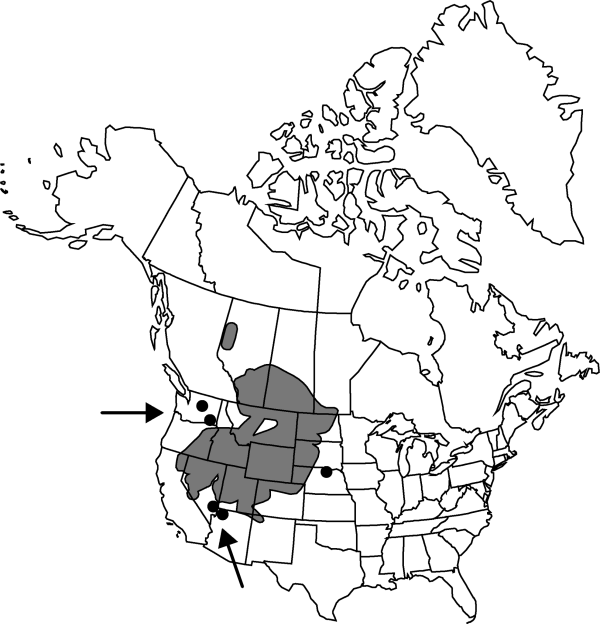Atriplex gardneri
Syn. Pl. 5: 537. 1852.
Shrubs or subshrubs, dioecious or monoecious, 1–10 dm, unarmed. Stems prostrate to ascending, or less commonly erect. Leaves ± persistent, alternate or opposite to subopposite (especially proximally), sessile to petiolate; blade linear to oblanceolate, obovate, spatulate, or orbiculate, 5–55 × 2–25 mm, base cuneate, margin entire (rarely dentate), apex retuse to obtuse or rounded. Staminate flowers yellow or brown, in numerous clusters 2–4 mm wide, in spikes or panicles 2–30 cm. Pistillate flowers in spikes or panicles to 30 cm. Fruiting bracteoles 2–9 × 2–9 mm, bearing tubercles or wings or tubercles aligned in 4 rows or rarely smooth, apex toothed and usually with 2 or more lateral teeth. Seeds tan or brown, 1.5–2.5 mm wide.
Distribution

Alta., Man., Sask., Ariz., Calif., Colo., Idaho, Mont., N.Dak., N.Mex., Nebr., Nev., Oreg., S.Dak., Utah, Wash., Wyo., Mexico.
Discussion
Varieties 7 (7 in the flora).
This is a widely distributed complex of intergrading genotypes of great phenotypic plasticity. The members occur commonly in fine-textured saline substrates in much of the western Great Plains and in the Intermountain Region. Diploids, triploids, tetraploids, and hexaploids (and higher polyploids, all multiples of the base number 9) are known within the complex, and hybrids are known not only between the constituents but with the other woody species which they contact, i.e., Atriplex canescens, A. confertifolia, and A. corrugata. Indeed, a case can be made for treating both A. gardneri and A. canescens within an expanded A. canescens. They are regarded here as forming two intergrading complexes, with some of the constituent varieties placed equally well within either of the species aggregations. The treatment essentially follows the alignment of taxa suggested by C. A. Hanson (1962), with the exception that they are reduced to varietal status and var. bonnevillensis and var. aptera are placed within the A. gardneri phase and not with A. canescens.
Selected References
None.
Lower Taxa
Key
| 1 | Fruiting bracteoles with 4 lateral wings or rows of tubercles; staminate flowers yellow or tan to brown; w Utah, e Nevada, and the w Great Plains | > 2 |
| 1 | Fruiting bracteoles lacking lateral wings, tubercles, when present, often ± aligned; staminate flowers dark brown or yellow, but if yellow; different or various distribution | > 3 |
| 2 | Staminate flowers mainly tan to brown; Great Basin | Atriplex gardneri var. bonnevillensis |
| 2 | Staminate flowers mainly yellow; w Great Plains | Atriplex gardneri var. aptera |
| 3 | Lower leaves opposite or subopposite; stems usually prostrate to ascending; from the Four Corners region n to Canada, and e to Manitoba, North Dakota, South Dakota, Nebraska and n Colorado | > 4 |
| 3 | Lower leaves alternate; stems often ascending to erect; various distribution | > 5 |
| 4 | Leaves mainly 1-2.5 cm wide, grayish green; bracteoles 5-9 mm wide, densely tuberculate; Uinta and Navajo basins, Utah, Colo rado, New Mexico | Atriplex gardneri var. cuneata |
| 4 | Leaves mainly 0.5-1.2 cm wide, green; bracteoles 2-5 mm wide, not tuberculate or the tubercles very short; ne Utah, n to Canada and w Great Plains | Atriplex gardneri var. gardneri |
| 5 | Staminate flowers mostly brown; fruiting bracteoles tapering to an acuminate apex, with apical teeth united 1/2 of length, lacking lateral teeth; Great Basin e to ne Utah, s Idaho, w Oregon, and e Washington | Atriplex gardneri var. falcata |
| 5 | Staminate flowers mostly yellow; fruiting bracteoles with apex either not acuminate or truncate, the apical teeth free, subtended by lateral teeth; various distribution | > 6 |
| 6 | Leaves mainly 5-15 times longer than wide; pistillate flowers in spikes; Grand County, Utah | Atriplex gardneri var. welshii |
| 6 | Leaves mainly less than 5 times longer than wide, or if longer then of different distribution; pistillate flowers in panicles; Great Basin e to Wyoming and e Utah (and nw Arizona) | Atriplex gardneri var. utahensis |